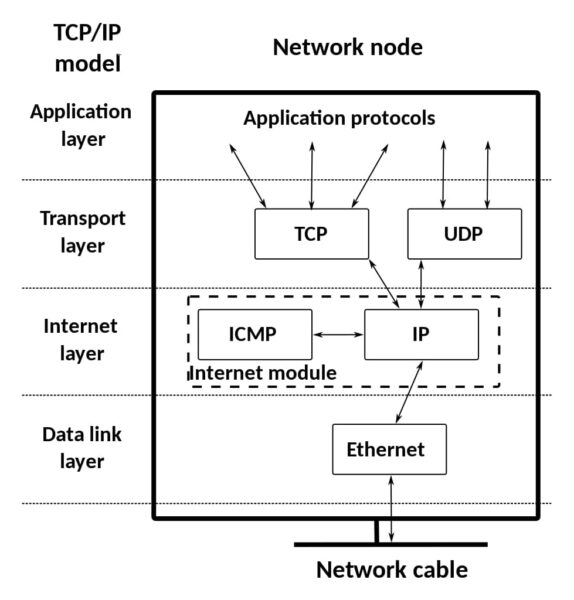✅ Last checked on
In today’s digital age, networking forms the backbone of our communication infrastructure. Whether you’re browsing the internet, sending emails, or streaming videos, you’re relying on networks to transmit data. At the core of these networks is TCP/IP, an acronym for Transmission Control Protocol/Internet Protocol.
TCP/IP serves as a set of rules that govern the communication between devices over the internet and local networks.
Let’s unravel the key components that constitute TCP/IP basics: understanding the fundamentals that make modern communication possible.
TCP/IP Basics: Understanding the Fundamentals

TCP/IP operates through a series of protocols and layers, each with a specific role in facilitating data exchange. Here’s an in-depth exploration of TCP/IP basics: understanding the fundamentals behind this intricate framework.
Protocol Suite Harmony
TCP/IP is often likened to an orchestra, where various instruments play in harmony to create beautiful music. Similarly, TCP/IP encompasses a suite of protocols, each responsible for distinct tasks. Some of the most notable protocols include:
- TCP (Transmission Control Protocol): Think of TCP as a reliable courier that ensures your data arrives intact. It breaks down large files into smaller packets, sends them to the destination, and ensures they’re reassembled correctly.
- IP (Internet Protocol): IP, on the other hand, handles the addressing and routing of data packets. It assigns unique IP addresses to devices and determines the best path for data to travel.
Layered Approach to Communication
TCP/IP operates through a layered architecture, where each layer focuses on a specific aspect of communication. This layered approach enhances efficiency and simplifies troubleshooting. The layers include:
- Application Layer: This top layer is the user’s entry point to the network. It deals with high-level protocols for tasks like email, file transfer, and remote access.
- Transport Layer: The transport layer, led by TCP, manages end-to-end communication. It ensures data reliability, flow control, and error correction.
- Internet Layer: IP resides here, handling the routing of data packets between devices. It assigns logical addresses (IP addresses) and facilitates the movement of data across networks.
- Link Layer: Also known as the network interface layer, this layer deals with hardware elements like network cards and switches. It’s responsible for packaging data into frames for transmission.
Decoding IP Addresses
IP addresses play a pivotal role in TCP/IP basics: understanding the fundamentals of addressing is essential. An IP address is a numerical label assigned to each device connected to a network. There are two types of IP addresses:
- IPv4: This version uses a 32-bit address, typically displayed in four sets of numbers (e.g., 192.168.1.1). However, the rapid growth of internet-connected devices has led to IPv4 address exhaustion.
- IPv6: To address the limitations of IPv4, IPv6 was introduced, featuring a 128-bit address. Its hexadecimal representation allows for an almost inexhaustible number of unique addresses.
Subnetting: Slicing Networks for Efficiency
Subnetting is a technique used to divide larger networks into smaller, more manageable subnetworks. This practice offers several benefits, including enhanced security, improved network performance, and simplified management.
By subnetting, network administrators can isolate departments or teams, preventing unnecessary traffic from congesting the entire network. This segregation also adds a layer of security by containing potential breaches within a smaller subnet.
FAQs
What is the primary function of TCP/IP?
TCP/IP serves as a protocol suite that governs communication between devices over networks, including the internet.
Why is IP addressing crucial in networking?
IP addressing is essential as it provides a unique identifier to each device on a network, enabling accurate data routing.
How does TCP ensure data reliability?
TCP breaks down data into packets, sends them to the destination, and ensures they’re reassembled in the correct order, minimizing errors.
What is the significance of subnetting?
Subnetting enhances network performance, security, and management by dividing larger networks into smaller, more efficient subnetworks.
Is IPv6 fully replacing IPv4?
While IPv6 is gaining traction, IPv4 is still widely used. The transition is gradual due to the vast existing infrastructure.
What role does the transport layer play in TCP/IP?
The transport layer, especially TCP, manages end-to-end communication, ensuring data reliability, flow control, and error correction.
Conclusion: Navigating the Network Seas with Confidence
In the realm of networking, understanding TCP/IP basics is akin to grasping the compass that guides ships across uncharted waters. With protocols, layers, IP addresses, and subnetting techniques under your belt, you’re equipped to navigate the intricacies of modern communication networks.
So, the next time you send an email or stream a video, remember the unsung hero working tirelessly in the background: TCP/IP, the foundation of seamless connectivity.
This article demystified TCP/IP for me. I now understand the difference between IPv4 and IPv6 addresses. The examples provided were really clear and easy to follow.
Great introduction to TCP/IP! The explanation of IP addresses and their role in networking was very informative. Looking forward to more articles like this!
Thanks for breaking down the fundamentals of TCP/IP. The clear definitions and practical examples made it easy to grasp. Can’t wait to apply this knowledge in my next project.